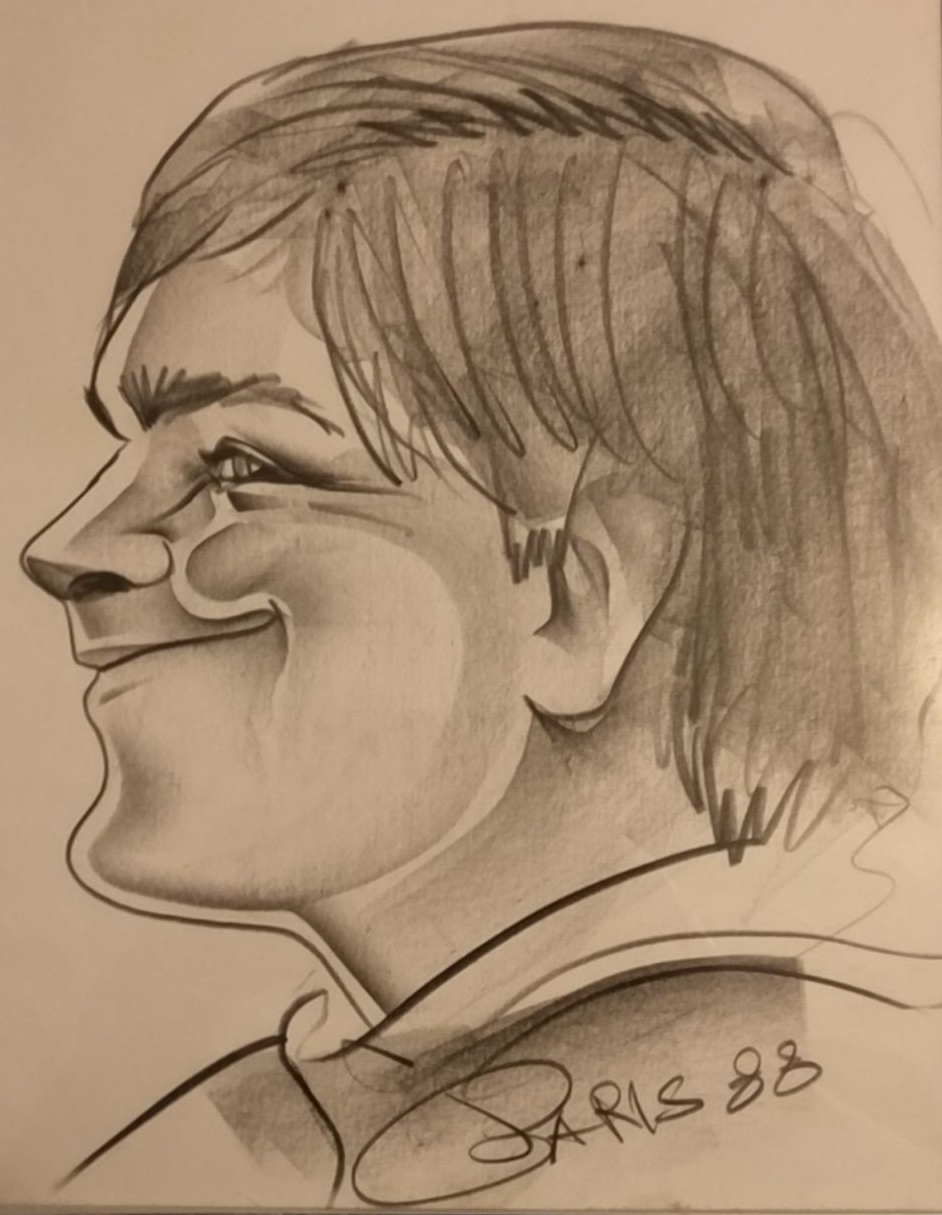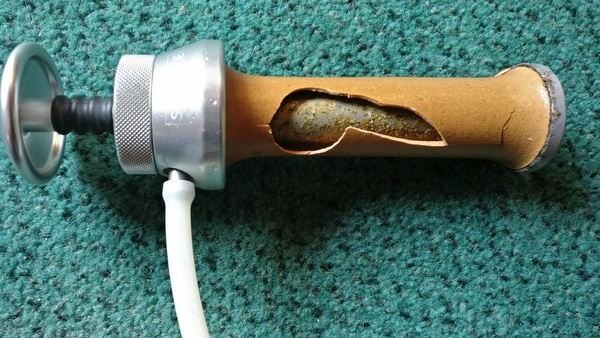I have a thing about glasses, cups, and containers for drinks of the water and non-alcoholic varieties, specifically for drinking iced tea (Nestea for those who are wondering), of which I drink really large amounts daily, and which itself is a personal trademark.
My obsession with drink containers is to the point that it would also be a bit of a personal trademark in and of itself except that, barring given containers that have been and/or are particularly noticeable or distinctive in their colouring scheme or design, most people would not notice my obsession because most of the containers I use — publicly, anyway — are actually rather mundane containers and cups.
That being said, I’ll start with what I use at home to drink my iced tea:
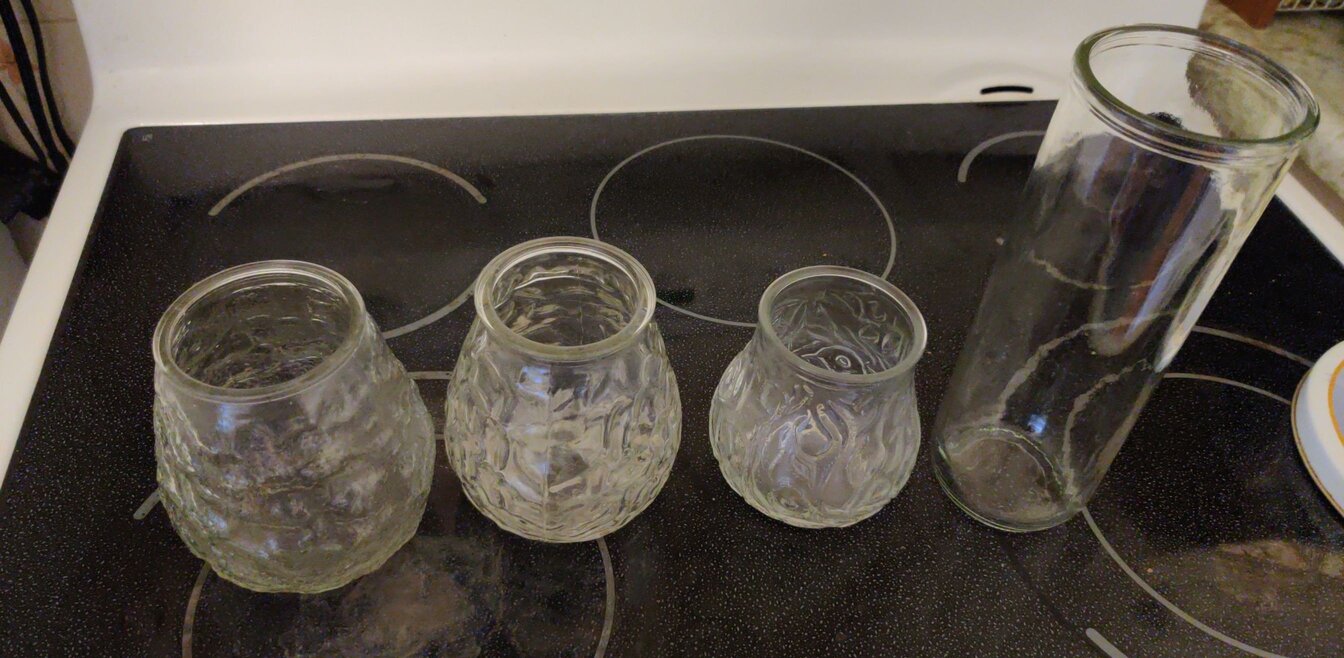
At home, my favourite drinking glasses are old glass candle holders of the variety that some restaurants have been known to have on their tables. I started using the glass candle holders back in the early 1990’s when I found one still with the wax in it; I took it home, reclaimed the wax for a hobby of mine that uses wax, and cleaned up the container. I have since found, cleaned, used, and unfortunately, broken well over a dozen of these containers over the years.
I also have a tall glass container that may have once served as a flower vase, which was found in a garbage bin.
When I go out, whether or not the drink container I use is distinctive enough to be a personal trademark depends on which container I bring with me. Below are three of my more distinctive containers:

The large “X-Treme Gulp” mug – the largest of them in the centre – holds about a litre and a half, and garners attention and incredulous comments to the order of it being “one really big coffee mug”. This was a surprise Christmas gift from my aunt in 2005; I had mentioned my interest in (at least somewhat) unusual drinking containers, and I probably joked about wanting a clownishly large container. That Christmas, a package arrived in the mail, with the mug in it. It is indeed clownishly large, and at the point of being unwieldy to use and drink from.
The yellow mug on the right holds about a litre, and garners similar attention. In 1995, I was driving around for work, and a yellow “something” caught my attention in a snow-filled ditch; I stopped and went to find it, and it was the thermal travel mug pictured above (but without a lid). Obviously, I grabbed it and took it home.
The smallest of them holds about a half litre, and its claim to fame is its wide bulbous base. In 1996, I was part of an organizing group for a party weekend with a wide group of friends, and we’d ordered a bunch of those travel mugs with custom artwork put on it memorializing the event — this one being the tenth edition of the event. We ordered enough for everybody to get one, so as to discourage people from leaving empty bottles of beer, liquor, and soft drinks laying around, which not only of course would have been a nuisance to clean up at the end of the weekend, but which also would have become a safety hazard when many of about a hundred, twenty-somethings became somewhat to very inebriated.
Found Containers
A particular characteristic many of the cups, mugs, and bottles which I have collected over the years is that they have been found on the street, or were found in recycling bins or the garbage.
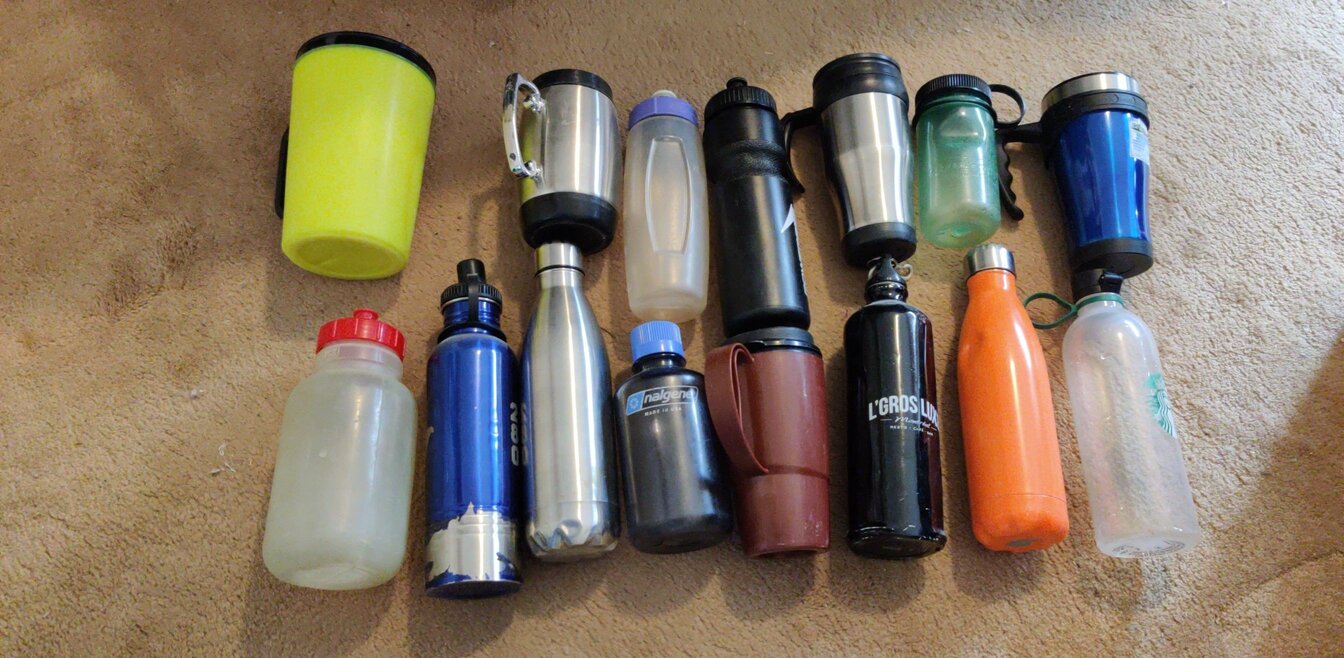
Most of these containers and mugs shown above have at various times been a favourite container of the moment, and have seen a lot of use over the years. In fact, the opaque container with the red top (second row, first on the left), which I found in the bushes while I was geocaching in 2002 or 2003, came with me on a trip to London, while the small greenish Nalgene container with the black lid (first row, second from right), was found in a lost and found pile in 2017, and went with me on a couple of cruises.
Of course, all containers I find on the street or elsewhere are properly washed in a dishwasher before I ever use them; it’s the same logic as “don’t you wash your dirty dishes before using them again?”
Unfortunately, a number of the bottles and cups I find in the street, including the stainless steel units, that were used for coffee, have a lingering coffee odour to them, and even after an initial cleaning, will impart a coffee taste when filled with a new drink. This is a mild issue for me since I do not drink coffee, nor do I particularly care for it. However, the taste disappears after a few uses and cycles in the dishwasher. Soaking in a mild bleach solution can help in extreme cases.
One virtually new travel coffee cup I found on the street in a snowbank in 2018 was branded with the logo of a well known goodwill organization; I imagine that the organization’s local major location being barely a block away made the chances of finding the mug there coincidental approaching zero. A family member guilted me into not using it, and tried to prevail upon me to return it to the organization. I ultimately gave the travel mug to my aunt when she visited, so that she may have a thermal coffee mug for when she were to go about her visits with friends.
Another travel mug I found in 2016 is a favourite given how well its lid seals (photo above, first row, third from the right); however, it has two little holes in its base, which allow water to enter in between the mug’s interior and exterior when I clean it in the dishwasher, upside-down. Mildly annoyingly — and a perverse reason why I like it all the more — it leaks a lot of water after I take it out of the dishwasher. However, its story lies in the corporate logo and company name which were silk-screened on it side; I was not familiar with the company name, and thought nothing of it, much as I would not think anything of most other common corporate logos on a mug. For months after finding the mug, I innocently used it everywhere, such as at work and other areas my life would bring me. One day, a work colleague saw my mug’s logo; he asked me if I knew what it meant, and suggested – in a suspiciously insistent way – that I should look it up. My immediate reaction was one of horror that it might be connected to a website of a particular type of explicit material (which could lead to unwanted consequences with my employer); I checked on my personal phone’s internet connection — of course not my work computer with the work internet — and found out that the logo was indeed generally connected with explicit websites. I quickly scraped the silk-screened logo off of the stainless steel exterior of the mug, and of course I continue to use the mug to this day.
Nalgene Water Bottles
Prior to learning about Nalgene containers for the consumer market in the early 1990s, and that they don’t absorb and retain flavours, then impart them in later contents, I only knew of Nalgene through school lab equipment such as squeeze bottles for lab-grade water and other reagents and solvents such as acetone and hexane.
Generally, I use Nalgene bottles for carrying water around, and I’ll drink my iced tea from another container or mug.
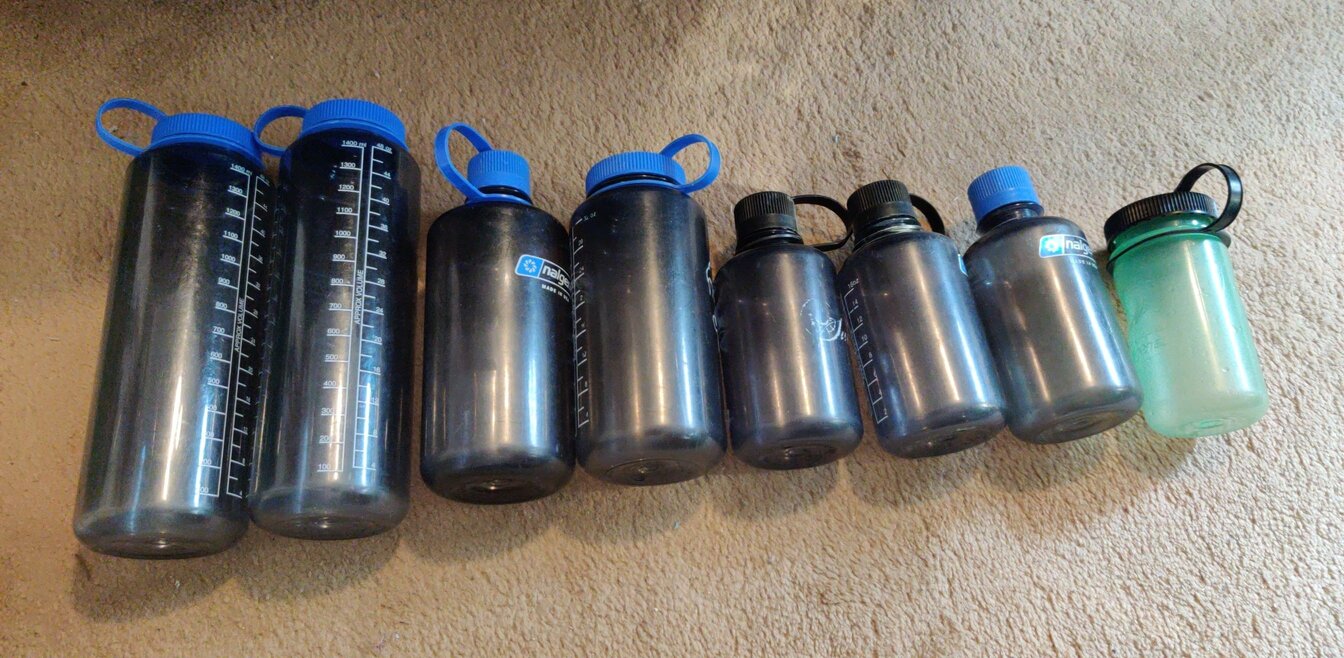
My first Nalgene bottle was one I found at a campsite in Vermont in 1994, left behind by previous users of the site. Unfortunately, after several years of service, I inadvertently left it – filled with water – in my car overnight in the middle of a particularly bitterly cold part of winter. The ice expansion caused the plastic in the bottle to split open, and I put it in the recycling bin.
Another early experience with Nalgene bottles was during a sales call with my employer in 1995, who showed a potential client two water samples — one murky, one clear — in clear Nalgene sample bottles in order to demonstrate his filtration device to recondition the process water or glycol in building heating and cooling loops. The sales demonstration was very effective on me, and I asked if I might be able to secure a bottle or two. I used the bottles he gave me for several years; however, the plastic was soft and over time became deformed by the heat in my dishwasher.
Over the years, I have found a Nalgene bottle in a recycling bin (second from the right, 500mL, blue cap), another in a lost and found bin (last on the right, green container, black cap), and others at used goods stores. My most recent acquisitions are two 1.5 litre bottles (first and second on the left), received as a recent Christmas gift (2019).
Stylish Insulated Stainless Steel Bottles
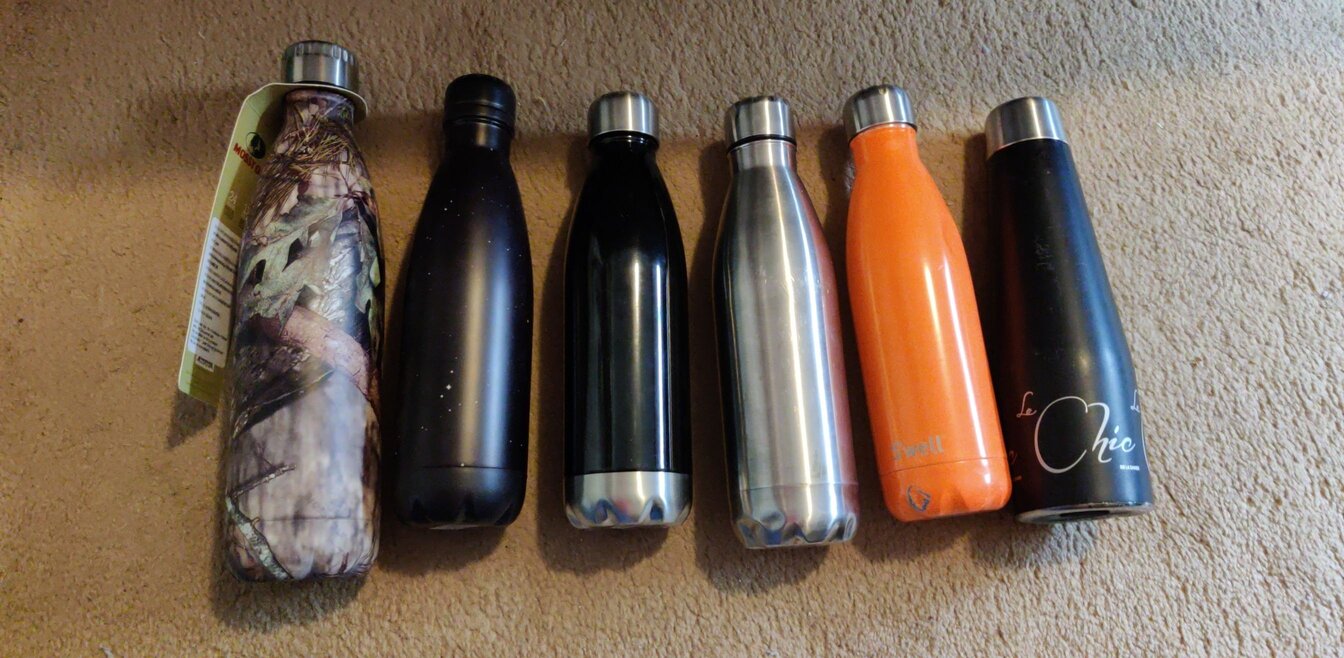
There are the relatively new fangled stylish insulated bottles that seem to have taken the water bottle market by storm. Although stainless steel insulated bottles and thermoses have been around for ages, S’Well and similar bottles seem to have started a style revolution in water containers over the past few years, with a lot of copycat competitors, ranging from low end look-alikes to high-end rivals.
I have three new such bottles which I have never used: One received from my employers in 2017, of course with corporate branding (third from the left), and which was the first time I’d seen the style; another received as a Christmas gift in 2018 (first on the left), which was a copycat; and one received as a promotional item during a themed cruise in 2018 (second from the left).
The only such bottles I actually use are the three I found on the street: A cheap discount store, single layer / uninsulated knockoff bottle in 2019 (third from the right); a salmon pinkish orange bottle of the S’Well brand in 2019 (second from the right), and a third, which I call “Le Chic” (because of the branding on it) in 2020 (last bottle on the right). All three show varying degrees of definite signs of wear and tear, and at least two leak very slightly, one a bit more than the other. The “Le Chic” bottle is a very recent addition, and it has the coffee taste issue mentioned earlier; it will probably enter into my regular usage rotation.
Glass Drinking Jars
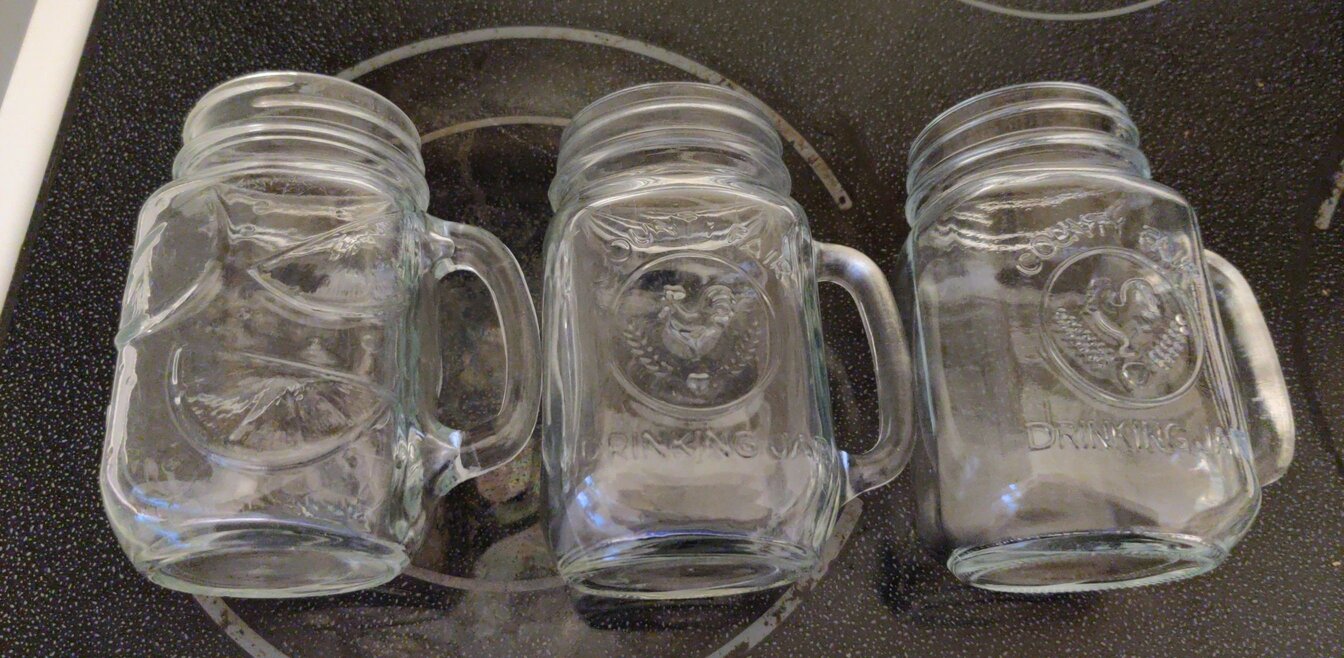
I have known about glass drinking jars for a long time, although I only first had one in 2006, when I bought two at the tuck shop at a campsite I was spending a long weekend at; they were relatively expensive, but I purchased them anyway.
Since then, I have found a few at Walmart (the fruit design on the left in the picture above) at a far more reasonable price. Of the other two, one was found on the streets when it caught my eye one morning, while the other was given to me by the recipient of some of my pickled eggs who was returning empty mason jars.
Save for the fact that they are glass and hence susceptible to breakage, these jars are great travel drink containers: In fact, I brought one with me as my main drinking container during a month long business trip out of province in 2009. It served me well, and it amused me when I used it on an airplane. Once I’d finished drinking the water the flight attendant poured into it, I put a lid on the drinking jar. When the airplane landed, I opened it, and was amused by the popping sound caused by the relative vacuum created due to slightly lower cabin pressure.
However, as to the breakage factor, they can be difficult to use on a daily basis in a backpack, since I have accidentally broken a couple of them over the years by simply putting down my backpack on a hard floor in a less than ginger fashion, unfortunately breaking the jar in the bag.
What’s Next on the Horizon?
Of course, I haven’t told the stories to all of the containers I’ve seen come and sometimes go, let alone some that never were. But that is, in a sense, part of the story: There have been so many over the years — including old plastic containers never meant to be used as drinking containers, but rather should have been placed directly in the recycling bin once the original contents were consumed, or finding really good quality travel mugs on the street with excellent seals, that allow me to vigorously shake it to dissolve the iced tea powder I added to the water in it. Oh, and the sort of pear-shaped clear 500mL bottles that a certain type of inexpensive, convenience-store table wine came in … I have fond memories of using those for several years throughout the 1990s.
And while over time I’ve had — and continue to have — favourite containers in the lot, the choice of which container(s) is(are) today’s or this week’s favourite can be ephemeral over time, especially as the overall collection grows with new additions, and contracts due to losses and breakage.
Also, while I actually (somewhat) zealously protect my containers, including very much those found for free, this has also led me have a certain zen when one goes missing, especially if it was one of the “found for free” containers. Just as I found the container because somebody else lost it before me, sometimes I lose containers, leave them behind locked doors to rooms to which I no longer have access, or they get confiscated at a public event such as at a stadium that doesn’t allow participants to bring in items like mugs and bags, both for safety reasons (projectiles), as well as to protect revenue streams from the concession stands.
But this is one of the fun things about what I dare call a hobby: The collection evolves and renews itself, and while I may “mourn” the loss of one of my containers, all I have to do is wait to find another “new to me” container or mug in my various travels, and I’ll end up with a new favourite container.

















